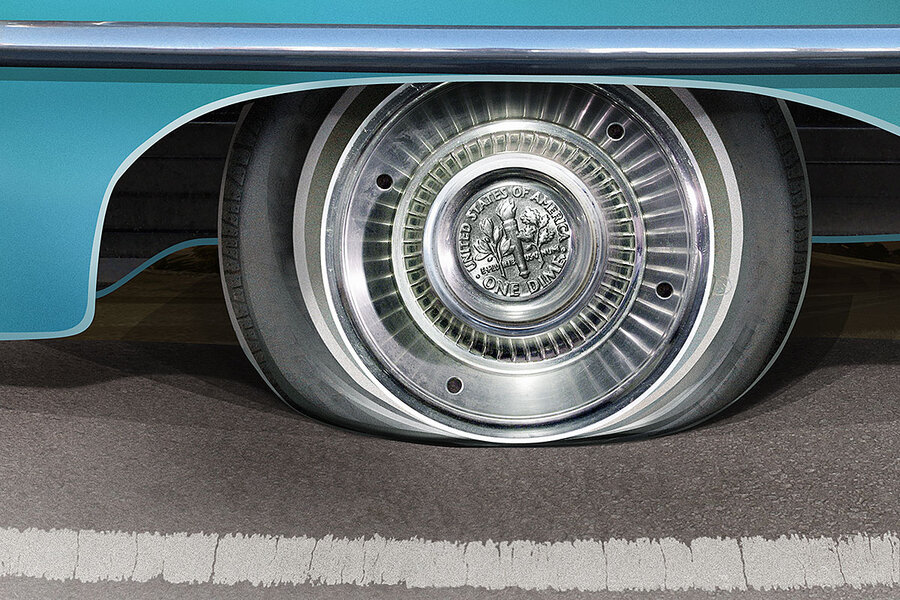My helper was closer than I thought
Loading...
Twenty-seven-and-a-half pounds may not seem like much. But to someone with spindly arms like mine, it can be a challenge. That’s how much our 1988 Chevy Suburban’s full-size spare weighed.
There’s no good place to have a flat tire. However, a well-lit area – away from traffic and close to people who can help – would be better than the narrow shoulder of an interstate in the middle of nowhere on a dark night.
But that’s where I sat, having a “Now what?” moment in the wake of a blown tire. This was before ubiquitous cellphones. (I knew one person who had one, and it was about the size of two Cracker Jack boxes taped together.) So I had no way to call for help. I’d been in the presence of a couple of tire changes but had never indulged in one myself. Perhaps someone would stop and help me.
I turned on the flashers and waited. While I waited, it occurred to me to do some preliminary things to assist the anticipated helper. I found the owner’s manual and the diagram that showed where they hid the jack.
I got out and confirmed that the blowout was the left-rear tire. Then I explored the cavernous area under the hood and found a relatively tiny jack. More research revealed where the jack should go and how to assemble it. I went ahead and got it positioned – to make it easier for my helper.
I also found the tool to loosen the lug nuts, feeling very mechanically savvy for knowing what lug nuts were. Reasoning that it would be better to loosen them before jacking up the vehicle, I did so – less work for my helper.
Traffic was light: only the occasional semi blowing past. That was good, because the distance between the tire and the edge of the pavement was less than two feet. On the other hand, little traffic made it less likely that someone would stop and help.
To avoid thinking about that, I studied the jack arrangement and decided to see if it really worked. It did! The wounded tire was now off the ground. It might be possible for me to remove it. With a bit of effort, I wrestled the tire off and rolled it around behind the Suburban. One more thing my helper wouldn’t have to do.
As long as I was back there, maybe I could get the spare out, too. I lowered the tailgate and climbed inside, where I found the huge spare resting in its indentation. I rocked it out, rolled it to the edge of the tailgate, and climbed down. Then I coaxed the spare over the edge of the tailgate and, none too gracefully, caught it before it rolled off into the dark ditch on the other side of the shoulder.
I rolled the spare around to its destination and leaned it against the side of the vehicle. How could I ever lift it high enough for the holes to go onto the thingies that the lug nuts attach to? (I was having doubts about that helper.)
While I pondered how to lift the spare, I went around to the back again and tackled the challenge of getting the busted tire into the Suburban. Fortunately, the blowout had ripped a long slit in the sidewall, and I stuck the fingers of both hands into the tear, grabbed hold, and swung the tire in a wide arc up onto the tailgate far enough for me to push it in the rest of the way.
Meanwhile, a solution to lifting the spare began to emerge. I sat flat on the ground, facing the target for the spare and bent my leg so my calf was in front of me. Then I rolled the spare onto my calf and scooted forward, lifted my knee, and – voilà! – slipped the holes onto the thingies! I hand-tightened the lug nuts.
Now all I had to do was lower the vehicle and tighten the lug nuts sufficiently to keep the wheel from coming off. I no longer felt the need to be rescued. In fact, now I hoped that no one would come along and get in my way!
I lowered the jack and put it back in its hiding place. To be sure the lug nuts were tight enough, I stood on the arm of the wrench for the last turn.
One hour and 29 minutes after the blowout, I started the engine. My spindly arms steered me back onto the pavement – with one of the greatest feelings of accomplishment I’ve ever experienced.







